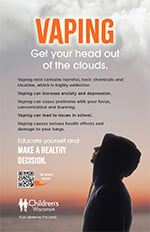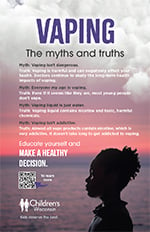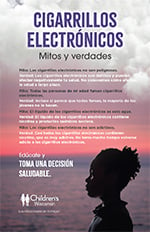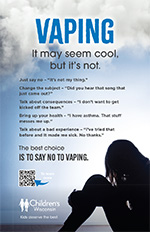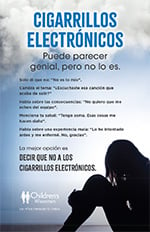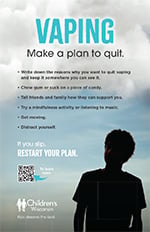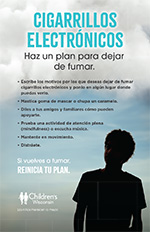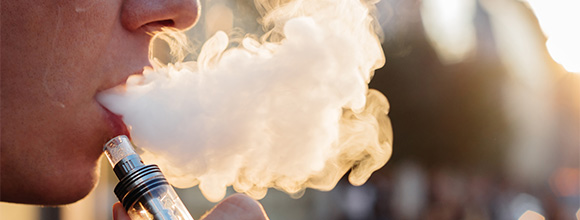
Vaping is an epidemic for young people across the country. You have probably seen people you know or care about vaping. The best choice for your health is to never vape. If you are addicted to vaping, there are things you can do to vape less often and quit.
- Vaping mist contains harmful chemicals and nicotine, which is highly addictive.
- Vape devices and liquids contain chemicals that cause cancer and toxic metals.
- Vaping is expensive.
- Vaping can cause anxiety.
- Vaping can lead to issues in school that include trouble sleeping, memory issues, trouble concentrating, changes in mood and trouble with impulse control.
- Vaping can make it hard to breathe, run and participate in sports or activities.
- Vaping can cause serious damage to your health.
- Vape devices lead to more plastic waste and e-waste because of the lithium-ion batteries.
- Most people don’t know how to properly dispose of their vape devices. Learn about the environmental harms of disposable vapes.
- Vape devices are hazardous waste. Some vape shops, businesses and collection sites offer proper device disposal. Vape devices can start on fire in garbage cans or in landfills. Visit this Wisconsin Department of Natural Resources webpage to learn more about hazardous waste disposal.
Myth: Everyone my age is vaping.
Truth: Even if it seems like they are, most young people don’t vape.
- Most teens don’t vape. Check out these facts about vaping (Spanish version) to learn more.
- According to the 2023 Wisconsin Youth Risk Behavior Survey Summary Report only one in three (34.4%) of students have tried vaping. Only one in six (15.7%) has vaped in the last 30 days and 5.25% of students reported vaping every day.
- 22.3% of students who currently vape also smoke cigarettes but 91.3% of students who smoke cigarettes also vape.
- Current vaping by grade level:
- 9th grade (10%)
- 10th grade (16%)
- 11th grade (16%)
- 12th grade (20%)
Myth: Vaping isn’t dangerous.
Truth: Vaping is harmful and can negatively affect your health. We don’t know all of the long-term health impacts of vaping.
- We do know that most people who quit vaping will start to heal.
- People who vape are more likely to get addicted to other drugs or risky behaviors.
- Most young people who smoke cigarettes also vape. So vaping isn’t a good way to stop smoking cigarettes.
Myth: Vaping liquid is just water.
Truth: Vaping liquid contains nicotine and harmful chemicals.
- Other chemicals include:
- Propylene glycol, which is often added to food but also found in antifreeze, paint solvent and fog machines.
- Vegetable glycerin
- Heavy metals
- Small particles that get deep into the lungs
Myth: Vaping isn’t addictive.
Truth: Almost all vape products contain nicotine, which is very addictive. It doesn’t take long to get addicted to vaping.
- Products that claim to not contain nicotine have been found to contain small amounts.
- THC vapes usually don’t contain nicotine, but these products are still addictive.
- People’s brains don’t stop developing until they’re about 25 years old. Drugs are most dangerous for growing brains.
Your peers might ask you if you want to vape. Here are some ways to tell them no:
- Just say no – “It’s not my thing.”
- Change the subject – “Did you hear that song that just came out?”
- Talk about consequences – “I don’t want to get kicked off the team.”
- Bring up your health – “I have asthma. That stuff messes me up.”
- Talk about a bad experience – “I’ve tried that before and it made me sick. No thanks.”
Try practicing saying your reason for not vaping out loud and in your own words. This can help make it easier to say no to vaping in real life.
The vaping industry is targeting young people so they can have customers for life. They want to make money. They do things like:
- Make packaging and devices in fun colors.
- Make vape devices sleek and easy to hide from parents and teachers.
- Add flavors that appeal to young people, like fruit or candy.
- Use advertising to make vaping look fun or cool.
- Claim that vaping is a good way to stop smoking cigarettes. Vaping is not a safe alternative to smoking.
There’s a lot of misinformation out there. Educate yourself and make a healthy decision.
Quitting vaping is hard. Here are some things you can do to quit:
- Make a plan to quit vaping and avoid triggers, or the things that make you want to vape.
- Remind yourself why you want to quit. Write it down and keep it where you can see it.
- Tell your friends and family how they can support you while you’re quitting.
- Chew gum or suck on a piece of candy to help get through a craving.
- Try a mindfulness activity or listening to music.
- Keep your hands busy and your mind focused. Things like drawing, adult coloring, playing with foam, clay or slime can help pass the time.
- Exercise or take a walk outside.
- Distract yourself for a while. Cravings usually only last 10-20 minutes.
- Remember, if you slip that’s okay. Just restart your quitting plan.
Resources you can use to quit vaping:
- Smokefree Teen is a web-based quit plan tool for teens that offers text and app support and teen specific management of triggers and cravings.
- Truth Initiative is a quitting text messaging program for teens, young adults and parents. Teens and young adults: text DITCHVAPE to 88709. Parents: text QUIT to (847) 278-9715.
- Wisconsin Quit Line is a 24/7 text or phone support line offering free coaching. They also offer medication or nicotine replacement therapy for ages 18 and older. Call 800-QUIT-NOW or text VAPEFREE to 873373.
- My Life, My Quit offers free and confidential coaching support for teens to quit vaping. Text Start My Quit to 36072.
- The American Lung Association offers quitting information and programs for teens, information to help someone else quit and a vape-free school program.




